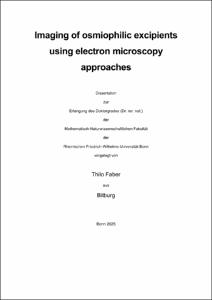Faber, Thilo: Imaging of osmiophilic excipients using electron microscopy approaches. - Bonn, 2025. - Dissertation, Rheinische Friedrich-Wilhelms-Universität Bonn.
Online-Ausgabe in bonndoc: https://nbn-resolving.org/urn:nbn:de:hbz:5-83977
Online-Ausgabe in bonndoc: https://nbn-resolving.org/urn:nbn:de:hbz:5-83977
@phdthesis{handle:20.500.11811/13312,
urn: https://nbn-resolving.org/urn:nbn:de:hbz:5-83977,
author = {{Thilo Faber}},
title = {Imaging of osmiophilic excipients using electron microscopy approaches},
school = {Rheinische Friedrich-Wilhelms-Universität Bonn},
year = 2025,
month = aug,
note = {Drug delivery systems usually contain excipients composed of light elements such as carbon and nitrogen, oxygen. These elements in particular make up the majority of active ingredients and excipients resulting in no or minor differences in electron density. However, the materials can have different affinities towards contrast-enhancing agents, so that it is possible to differentiate between the various materials on the basis of the changes in electron density after contrasting. Cellular delivery of nanomedicines using drug delivery systems face similar challenges. Common excipients used for cellular delivery are composed of light elements and are thus nearly indistinguishable from the surrounding biological material.
Resulting from this, the main objective of this work is the visualization of pharmaceutical excipients in drug delivery systems and cells by electron microscopy using contrasting techniques. To achieve this, contrast enhancement strategies using osmium tetroxide as well as ruthenium tetroxide are explored. Contrast enhancement strategies are of particular interest for the technique of focused ion beam scanning electron microscopy (FIB-SEM), which has attracted great interest in recent years as a novel tool for the characterization of drug delivery systems. Neither contrast enhanced drug delivery systems nor imaging of cellular ultrastructure after nanoparticle treatment by electron microscopy are commonly imaged in the field of pharmaceutics.
With these approaches, it was possible to visualize the localization of a self-emulsifying drug delivery system (SEDDS) within the porous silicate carrier Florite R using scanning electron microscopy (SEM) and FIB-SEM. SEDDS-loaded Florite R-containing tablets prepared by compaction and vacuum compression molding (VCM) were also imaged using this approach.
In addition to the electron microscopic characterization of drug delivery systems, the uptake of lipid nano carriers consisting of unsaturated lipid excipients after staining with osmium tetroxide was visualized using SEM and scanning transmission electron microscopy (STEM). The lipid nano carriers were rapidly digested as indicated by Lipid droplet formation. Nevertheless, the lipid nano carriers could successfully be visualized within the endolysosomal system especially after chloroquine co-treatment.
These investigations will benefit our understanding of ultrastructural features of drug delivery systems and cellular trafficking of drug delivery systems.},
url = {https://hdl.handle.net/20.500.11811/13312}
}
urn: https://nbn-resolving.org/urn:nbn:de:hbz:5-83977,
author = {{Thilo Faber}},
title = {Imaging of osmiophilic excipients using electron microscopy approaches},
school = {Rheinische Friedrich-Wilhelms-Universität Bonn},
year = 2025,
month = aug,
note = {Drug delivery systems usually contain excipients composed of light elements such as carbon and nitrogen, oxygen. These elements in particular make up the majority of active ingredients and excipients resulting in no or minor differences in electron density. However, the materials can have different affinities towards contrast-enhancing agents, so that it is possible to differentiate between the various materials on the basis of the changes in electron density after contrasting. Cellular delivery of nanomedicines using drug delivery systems face similar challenges. Common excipients used for cellular delivery are composed of light elements and are thus nearly indistinguishable from the surrounding biological material.
Resulting from this, the main objective of this work is the visualization of pharmaceutical excipients in drug delivery systems and cells by electron microscopy using contrasting techniques. To achieve this, contrast enhancement strategies using osmium tetroxide as well as ruthenium tetroxide are explored. Contrast enhancement strategies are of particular interest for the technique of focused ion beam scanning electron microscopy (FIB-SEM), which has attracted great interest in recent years as a novel tool for the characterization of drug delivery systems. Neither contrast enhanced drug delivery systems nor imaging of cellular ultrastructure after nanoparticle treatment by electron microscopy are commonly imaged in the field of pharmaceutics.
With these approaches, it was possible to visualize the localization of a self-emulsifying drug delivery system (SEDDS) within the porous silicate carrier Florite R using scanning electron microscopy (SEM) and FIB-SEM. SEDDS-loaded Florite R-containing tablets prepared by compaction and vacuum compression molding (VCM) were also imaged using this approach.
In addition to the electron microscopic characterization of drug delivery systems, the uptake of lipid nano carriers consisting of unsaturated lipid excipients after staining with osmium tetroxide was visualized using SEM and scanning transmission electron microscopy (STEM). The lipid nano carriers were rapidly digested as indicated by Lipid droplet formation. Nevertheless, the lipid nano carriers could successfully be visualized within the endolysosomal system especially after chloroquine co-treatment.
These investigations will benefit our understanding of ultrastructural features of drug delivery systems and cellular trafficking of drug delivery systems.},
url = {https://hdl.handle.net/20.500.11811/13312}
}






